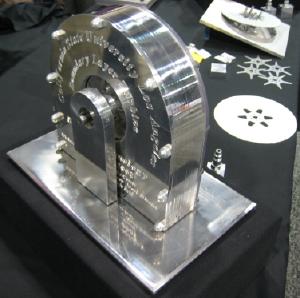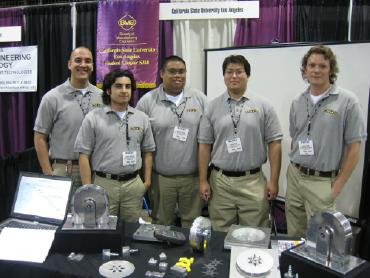Note to editors and news directors: To make arrangements for photos or interviews, please contact the CSULA Public Affairs at (323) 343-3050.
With turbines’ high efficiency, Cal State L.A. students generate first place
WESTEC Manufacturing Challenge exposes students
to the world of manufacturing technology
Los Angeles, CA – Demonstrating outstanding manufacturing technology skills, teamwork and problem-solving abilities, Cal State L.A.’s technology student team placed first in the university category for its boundary-layer turbines at the WESTEC 2008 Manufacturing Challenge, a creative annual manufacturing competition where college students design and manufacture products for judging by manufacturing professionals.
Beating out more than 11 participating colleges and universities, Cal State L.A.’s winning team includes Blake Cortis (senior, North Hollywood resident), Thomas Cisneros (senior, Los Angeles), Danley Dizon (senior, Rancho Cucamonga), Mike Frausto (junior, Los Angeles), and Mark Hirami (junior, San Gabriel). The event was held recently at the Los Angeles Convention Center.
Under the direction of faculty advisor Jai Hong, associate professor of industrial technology, along with support by technical staff members Bruce Fisher and Chris Reid, the team developed two 6-inch boundary-layer turbines. Converting aerodynamic drag into rotational movement, the turbines are capable of producing 20 HP (horsepower) at 9,000 RPM (revolutions per minute) and can reach up to 16,000 RPM.
Professor Hong explained, “For the competition, the students were to develop two turbines that can be used in place of electrical or heating engines, such as a micro-sander attached to a flex shaft. They also can be utilized in clean-room environment because there is no need for lubrication and they have a self-cooling capability. The turbines are stand-alone units that require nothing more than standard compressed air to operate.”
Following are the stages involved with manufacturing the project:
(1) With a low-input air pressure (100 PSI), the team designed, developed and tested multiple inlet nozzles to dramatically increase the input velocity of the air flow to the turbines.
(2) Critical parts contributing to proper operation of the turbines then undergone severe testing by means of computer-assisted design and analysis, and rapid prototyping.
(3) The final machining processes included manual machining as well as sophisticated automated machining processes.
According to Hong, “Although designed and manufactured on a small scale, the turbines display an ability to perform at high levels of efficiency in many industrial and commercial applications.”
The WESTEC Challenge, Hong said, underscores the important connection between classroom lecture/lab activities and industrial applications.
Celebrating its 45th year, WESTEC is the largest North American machine-tool and advanced-manufacturing event. It is cosponsored by the Society of Manufacturing Engineers.
For more information, call the Department of Technology at Cal State L.A., (323) 343-4550.
# # #
Pictured (l-r): Mike Frausto, Thomas Cisneros, Danley Dizon, Mark Hirami, and Blake Cortis.
Working for California since 1947: The 175-acre hilltop campus of California State University, Los Angeles is at the heart of a major metropolitan city, just five miles from Los Angeles’ civic and cultural center. More than 20,000 students and 200,000 alumni—with a wide variety of interests, ages and backgrounds—reflect the city’s dynamic mix of populations. Six colleges offer nationally recognized science, arts, business, criminal justice, engineering, nursing, education and humanities programs, among others, led by an award-winning faculty. Cal State L.A. is home to the critically-acclaimed Luckman Jazz Orchestra and to a unique university center for gifted students as young as 12. Among programs that provide exciting enrichment opportunities to students and community include an NEH- and Rockefeller-supported humanities center; a NASA-funded center for space research; and a growing forensic science program, housed in the Hertzberg-Davis Forensic Science Center. www.calstatela.edu

